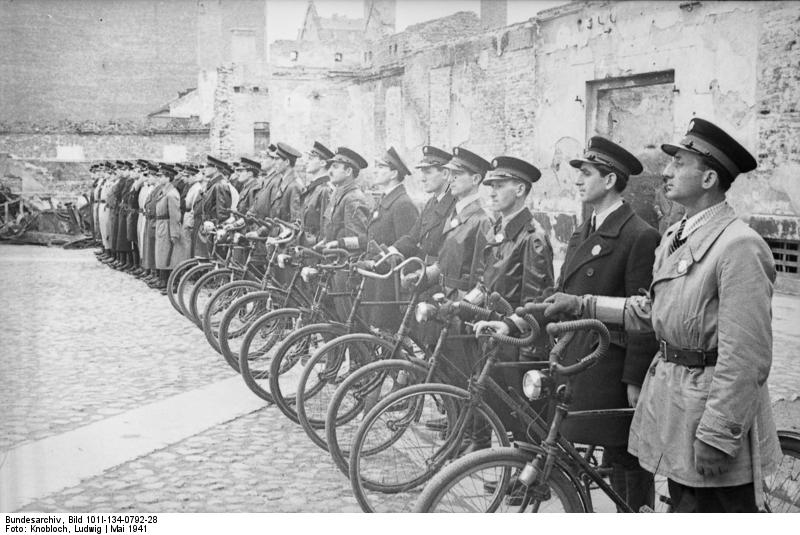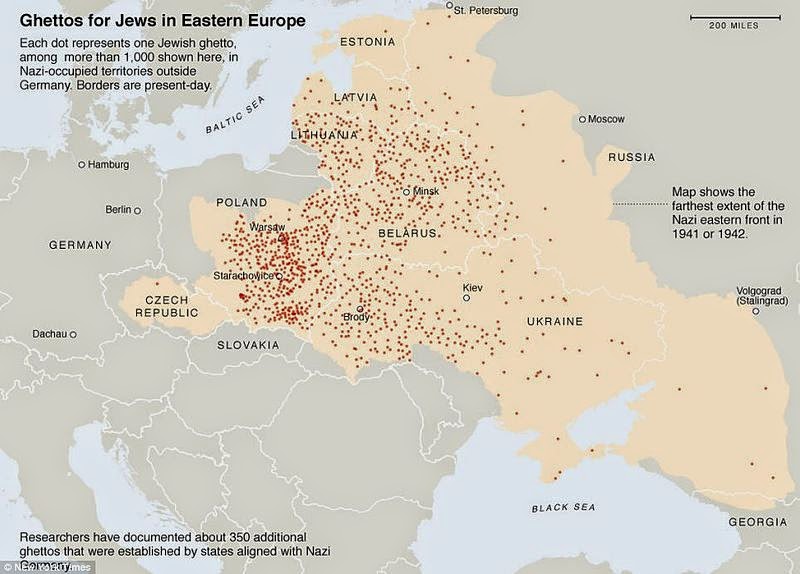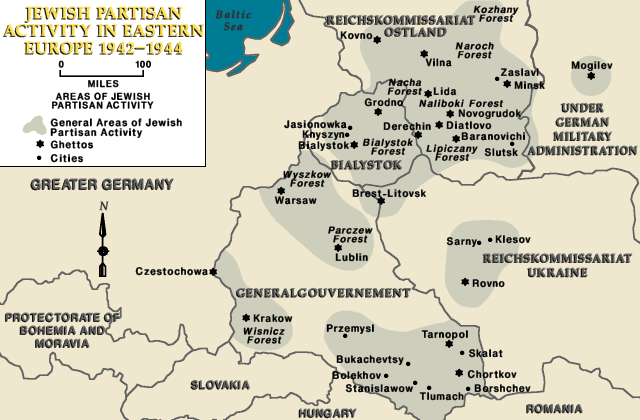The Mechanism of Mass Murder (1) – Ghettos
The first major death category is the ghetto system. Ghettos were generally small sections of cities that were designated as Jewish-only areas. They began to be formed in early 1940; Lodz (Poland) was one of the first. Most were established by the end of 1941—more than 1,000 in total, so we are told. From early 1943, they began to be dismantled; the average life of a ghetto was roughly two years.
Contrary to popular belief, ghettos were not prisons. Many were completely open, and Jews could come and go as they pleased—they were only confined to living and operating businesses there. Often times, the ghetto was marked only by a sign. Clearly they were never intended as a means of mass killing. Longerich evidently agrees: “The establishment of the ghettos was carried out so haphazardly and slowly that it would be wrong to see it as a systematic policy ultimately aimed at the physical annihilation of the Jews” (2010: 166).
Ghettos were, however, the logical first step in a program of exclusion, removal, and expulsion (‘extermination’). If the National Socialists indeed wished to ethnically cleanse the Reich, they would have begun by rounding up Jews, confining them to specified areas, and then methodically transporting them out. And this is precisely what happened. The two largest ghettos—Lodz (200,000 Jews) and Warsaw (400,000-590,000)[24]—were established in February and November 1940, respectively. Jews were confined (in the manner just described) there until new areas opened in the East, upon which time the deportations commenced.
 Group of Jewish ghetto policemen lined up with bicycles in the Warsaw Ghetto, Poland, May 1941.
Group of Jewish ghetto policemen lined up with bicycles in the Warsaw Ghetto, Poland, May 1941.Once again, it is instructive to keep the big picture in mind. From the perspective of the Holocaust, there is one big question here: How many Jews died in the ghettos? Given the years of study, there should something approaching common agreement on what that number is, and how it is derived. It should be the lodestar, the central point around which all discussion of the ghettos revolves. It should be everywhere that the ghettos are examined. And yet we find it—nowhere.
It does not appear in either older sources or newer, in print or online. Friedman’s (1954) detailed study, for example, lists no death figures at all, either for individual ghettos or as a whole. More recent sources are little better. Corni’s (2003) chapter on “Life and Death” in the ghettos gives a scattering of mortality statistics, but nothing comprehensive. He provides detailed—down to the individual—monthly deaths for the two largest ghettos (Warsaw and Lodz), but only for 10 and 18 months, respectively (pp. 205-206). But he draws no overall conclusions from these. He closes the chapter by citing the National Socialist statistician R. Korherr, who allegedly claimed that 760,000 Polish Jews died in ghettos through December 1942 (p. 218)—though this total is clearly marked by Korherr as the sum of “emigration, excess mortality, and evacuation.”
In his “definitive” study, Longerich (2010: 167) allots just one vague sentence to these deaths. Citing Hilberg (2003), he writes that “the total of Polish Jews killed prior to and during the period of ghettoization before the violent ghetto clearances began was approximately 500,000.” Only Polish Jews? Many countries had ghettos. And what does “prior” mean? And why exclude the “violent clearances”? And what was the basis for Hilberg’s figure—the man who could find only 5.1 million deaths overall?
Or consider Dean (2010); he provides exactly the kind of concise summary that should include an overall death figure, and yet we find only two mortality numbers, both for the Warsaw ghetto (more on this below). Perhaps appropriately, one of the newest dedicated studies, Michman (2011), has no death statistics at all.
Online sources are equally deficient. Wikipedia (“Jewish Ghettos in German-occupied Poland”) provides a nice list of 272 ghettos, including “number of Jews confined” (maximum? average? final?), but no death statistics, nor even references to any. It does list the presumed destination of the ghetto residents; virtually all went to one of the six extermination camps, directly or indirectly. These will be examined shortly. The USHMM website (“Ghettos”) gives no numbers, and states only that “the Germans and their auxiliaries either shot ghetto residents in mass graves located nearby, or deported them, usually by train, to killing centers where they were murdered.” How many mass graves? Where are they? Have they been examined? No answers. Yad Vashem says simply, “Many Jews died in the ghettos.”[25]
We must keep in mind how simple our request is. The essential equation is this: Jews went into the ghettos; some died there; the remainder were shipped out. More explicitly:
(# Jews in ghettos) = (# Jews died in ghettos) + (# Jews deported out)This again is elementary logic, and yet it seems to exceed the grasp of our traditional historians. Why can’t we get even rough estimates of this basic equation?
Since it is evidently too taxing a demand to request overall death statistics, let’s make it easier. Let’s look at the single largest and most-examined ghetto, Warsaw. Here we theoretically know everything, and in great detail. Even back in 1954, Friedman could write, “The bibliography of publications on the Warsaw ghetto is so extensive that it is impossible to enumerate even the more important studies” (p. 79, n 76). How much more detailed is our knowledge today—60 years later?
Once again, we ask the basic question: How many Jews died in the Warsaw ghetto? Once again, we come away empty-handed. No sources provide even a plausible estimate of this essential number.
In fact, our experts cannot even clearly answer the simpler question: How many Jews were in the Warsaw ghetto? Friedman (1954: 79) says 420,000 to 500,000. Corni (2003: 195) says 400,000. Dean (2010: 342) says “some 450,000.” Longerich (2010: 167) says 410,000 to 590,000! If we don’t know how many people we have to start with, we certainly can’t answer the follow-on questions regarding deaths and deportations. And if we can’t answer those questions, well, our entire picture of the Holocaust is up in the air.
Unlike the hundreds of other ghettos, we do have some partial death statistics for Warsaw. Corni (2003: 206), for example, gives us a table with monthly death figures, running from January 1941 to June 1942; these average 3,853 per month. But why stop there? The ghetto existed for another full year. Can we extrapolate this monthly figure for the entire duration? This would imply some 120,000 total deaths. If not, why not?
If so, how do we reconcile this number with the following facts presented by the USHMM?:
-“83,000 [ghetto] Jews died of starvation and disease” between 1940 and mid-1942;
- Between July and September 1942, “the Germans deported about 265,000 Jews from Warsaw to Treblinka”;
- Upon closing the ghetto in mid-May 1943, 42,000 were deported to three camps, 7,000 died fighting, and another 7,000 were shipped to Treblinka;
- 11,500 Warsaw Jews survived in the city until it was captured by the Soviets in 1945.[26]
For all that, no overall death number—for the most well-known and thoroughly studied ghetto of them all.
For that matter, what was Corni’s source for his numbers? As good sleuths, we must always ask such questions. In this case, it is particularly revealing. He cites an obscure, undated (presumed 1960) German text, Faschismus—Getto—Massenmord. This in turn is a translation from an even more obscure, also undated (presumed 1957) Polish source. Page 138 of this text has one table with the numbers used by Corni. But even here there are problems. There is no accompanying explanation at all—no elaboration, no context, nothing. Also, the entry for December 1941 is 43,239—a ridiculously high figure, and obviously incorrect, and thus Corni uses the number (4,366) from the accompanying chart. But if there are such gross and blatant errors, how can we trust any of the numbers?
One reason for the reluctance to establish an overall death toll may be the obvious lack of evidence—that is, absence of victims’ bodies. Based on Corni’s data, the Warsaw ghetto yielded nearly 130 corpses per day, on average, for two or more years. What did they do with the bodies? They could not bury them, as they were in the middle of a large city. They had no crematoria, nor wood to build pyres. So—what happened to the bodies? And are there any remains that we might examine today, in order to confirm things?
Unsurprisingly, none of our ghetto experts addresses this thorny issue. At best we find mere passing comments in other sources. For example, in a 1942 article in the NYT, we read that the Warsaw Jews “have no means for funerals, so the dead are put into the street, where they are collected by the police” (Jan 7; p. 8 ). (The same article, incidentally, claims that 300 per day were dying, mostly due to typhus—the very disease that the Germans were trying so hard to forestall.) If the police collected the bodies—4,000 or 5,000 per month—what did they do with them? Bury them? If so, where? Did they even count them? More unanswered questions.
Without such answers, we cannot really trust any information here. For all we know, the actual numbers could have been much lower. If there were 400,000 Jews in the Warsaw ghetto, this would imply 4,000 natural deaths per year, or about 11 per day. With this lower number, we can well understand how the bodies may have ‘disappeared’ without a record. But Corni and others tell us that some 130 Jews died every day—ten times the natural rate. The NYT said 300 per day, or 30 times the natural rate. These are much harder to explain.
Or maybe it was even worse than we presume. In one striking 1943 report in the NYT, we read that “approximately 10,000 people are killed daily in Warsaw alone by different means; the cruelest and most inhuman instruments, which only the black satanic spirit of Hitlerism can invent, are employed” (7 Feb; p. SM16). Think of it—10,000 per day! In a ghetto area of barely over one square mile! Perhaps the reporter, the “noted novelist” Sholem Asch, was guilty of a bit of poetic license. When we are dealing in fiction, anything goes.
It must be kept in mind how simple an analysis we are seeking. The main points could be addressed in a single paragraph. Here’s how it might go:
“The Warsaw ghetto held 350,000 Jews at its opening, a number that peaked at 450,000 in mid-1942 and declined to 80,000 when it was closed in May 1943. Overall, 500,000 Jews passed through the ghetto. Of these, 40,000 died in the ghetto of natural causes, and 10,000 were shot there by the Nazis. The 50,000 bodies were dumped into three mass graves in a nearby forest, which were exhumed and studied in 19xx. The remaining 450,000 people were eventually transported out of the ghetto—300,000 to Treblinka, 100,000 to Majdanek, and 50,000 to other concentration camps.”That’s it—very simple, very concise, and everything adds up. Of course these numbers are purely fictitious. We look to the experts to supply actual statistics. But answers are not forthcoming. And if the well-known Warsaw ghetto holds such mysteries, we can only imagine the murky state of the overall ghetto picture.
In the end, we are left with an empty sack. We must account, somehow, for roughly 1 million deaths in the ghettos. Yet we have no useful data on even the largest and best-studied ghettos. Furthermore, we must always keep in mind the natural death rate. If, for example, 3 million Jews (a rough guess, but certainly an upper limit) were confined to our “1,000 ghettos,” we then would expect some 30,000 deaths per year—or nearly 100 per day—due strictly to natural causes. One hundred deaths per day, spread over several countries and some 1,000 different locations, could easily vanish amidst a major war. But more to the point, this would yield only some 100,000 deaths in total—a mere 10% of the claimed figure.
By concentrating the Jews, the Nazis certainly contributed to infectious diseases, malnourishment, and other maladies, and thus must be held responsible for those ‘excess’ deaths, along with any isolated shootings or other direct actions they committed. But we have no idea how many such deaths occurred.
Let’s summarize our problem here. The ghetto system ran essentially for three years: 1941-1943. Over this time period, we are told, 1 million ghetto-deaths occurred; hence almost 28,000 per month, on average, or about 925 per day. Every day, somewhere in the system, 925 bodies were either buried or burned. Somewhere, in total, there are the remains of 1 million people. Or so we are told.
And yet have no record of any such bodies whatsoever—no mass graves, no crematoria, no open-air pyres, no ‘dumping in the river’ stories—nothing. Not even the natural deaths are accounted for, which causes us to suspect that the total number of interned Jews was perhaps much smaller than claimed. And if we can’t find the victims, how can we hope to solve the crime?




